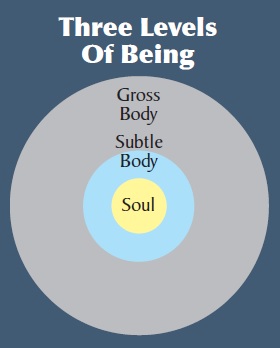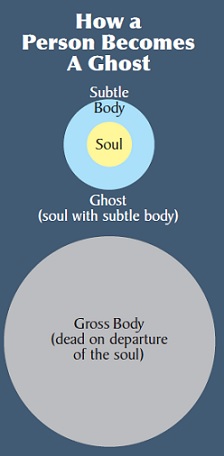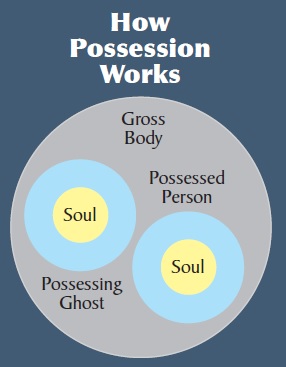
Despite the disapproval of scientists, many people believe in ghosts. What does the Vedic literature have to say on the subject?
Do ghosts exist? Yes would be the answer of many people across history and geography. Nearly universal in human experience are reports of people seeing, hearing, or perceiving in some other way disembodied, ghostly beings that seem to act in mysterious and frightening ways. In our scientific times, many of us may tend to dismiss the whole idea of ghosts as unscientific folk fantasy. However, several eminent scientists have taken ghosts quite seriously.
Prominent among ghost-believing scientists was the English naturalist scientist Alfred Wallace, the cofounder of the theory of evolution. In his autobiography, My Life: A Record of Events and Opinions, he outlines how the evidence forced him to give up his anti-ghost bias:
The majority of people today have been brought up in the belief that miracles, ghosts, and the whole series of strange phenomena here described cannot exist; that they are contrary to the laws of nature; that they are the superstitions of a bygone age; and that therefore they are necessarily either impostures or delusions. There is no place in the fabric of their thought into which such facts can be fitted. When I first began this inquiry it was the same with myself. The facts did not fit into my then existing fabric of thought. All my preconceptions, all my knowledge, all my belief in the supremacy of science and of natural law were against the possibility of such phenomena. And even when, one by one, the facts were forced upon me without possibility of escape from them, still . . . every other possible solution was tried and rejected. . . . We ask our readers not for belief, but for doubt of their own infallibility on this question; we ask for inquiry and patient experiment before hastily concluding that we are, all of us, mere dupes and idiots as regards a subject to which we have devoted our best mental faculties and powers of observation for many years.
Another eminent scientist convinced by the evidence was the reputed American psychologist William James: “So when I turn to the rest of the evidence, ghosts and all, I cannot carry with me the irreversibly negative bias of the ‘rigorously scientific’ mind, with its presumption as to what the true order of nature ought to be.” (William James on Psychical Research, edited by Gardner Murphy and Robert Ballou)
The evidence weighs more than ever before nowadays as many well-documented books report evidence accumulated using rigorous scientific procedures by several paranormal researchers.
Paralleling this significant evidence, and possibly boosted by it, is the substantial public belief in the existence of ghosts. A Gallup survey conducted in 1990 showed that:
• 29 percent of Americans believed in ghosts haunting houses
• 10 percent of Americans claim to have seen or been in the presence of a ghost
Despite the increase in documented evidence and popular acceptance, the concept of ghosts remains unacceptable for most scientists. A primary reason for this is that modern materialist science has no conceptual structure within which to account for the existence of ghosts. This limitation is not intrinsic to science per se, though it may be essential to materialist science. But there is no scientific reason to assume that all science has to be materialist, because there is no scientific evidence that all of reality exists only at the material level.
For those open-minded and adventurous enough to explore nonmaterialist worldviews, Vedic wisdom offers a systematic explanatory framework for understanding the existence of ghosts.
Three Levels of Being
 To aid our understanding of ghosts, let’s first familiarize ourselves with the three levels of existence as explained by Vedic wisdom.
To aid our understanding of ghosts, let’s first familiarize ourselves with the three levels of existence as explained by Vedic wisdom.
1. The gross material level: This level comprises the physical reality we can perceive with our senses and with instruments like microscopes that extend the capacities of our senses. Mainstream materialist science focuses on this gross material level of reality primarily, if not exclusively.
2. The subtle material level: This level comprises the mind, the intelligence, and the ego, or, more accurately, what the Vedic literature refers to as the false ego, our sense of identification with the physical body and materially conditioned mind. For the sake of brevity, I will sometimes refer to this entire level as the level of the mind or the mental level.
3. The spiritual level: The soul, the source of consciousness and true ego, exists at this nonmaterial level.
Germane to our discussion of ghosts is the difference between the mind and the soul. The mind, though invisible, is not spiritual; it is material, though made of a subtle material substance that renders it imperceptible to our gross senses. The mind, being material, is not conscious; the soul alone is conscious. The mind belongs to the subtle level between the spiritual and the gross material. From this intermediate position the mind acts as the conduit for the consciousness of the soul to interact with the gross body. Functionally, the mind becomes a storehouse of impressions acquired from interacting with the gross material level. These impressions comprise, among other things, memories of the past and desires for the future.
With this grounding in basic Vedic ontology, let’s now understand how and why some people become ghosts.
The Disembodied And Distressed
At the time of death the soul accompanied by the subtle body leaves the gross body. Normally, the soul gets a new gross body according to its karma. But in exceptional cases when the soul does not get a new gross body, then it stays in a disembodied state. Souls living this disembodied existence are called ghosts.
Of course, ghosts are not entirely disembodied; they still have a subtle body. But because in general parlance the word “body” connotes a gross body, the state of existence without that body is called “disembodied.”
Why don’t these ghosts get a physical body?
1. Suicide: People who destroy their physical body through suicide prematurely, that is, before they have become entitled by their karmic destiny to receive a new body, sentence themselves to a disembodied existence as ghosts till they are allocated a new physical body. Srila Prabhupada states, “Ghosts are bereft of a physical body because of their grievously sinful acts, such as suicide.” Thus, frustrated people who imagine that death is the end of existence and so commit suicide to become free from misery find themselves in an even more miserable existence as a ghost.
2. Extreme attachment: Those who die with extreme attachment to their physical body, environment, or possessions may also become ghosts. During such deaths, the excessive and intensive obsession of the mind with the past may prevent the soul from moving on and thereby keep it disembodied. Srila Prabhupada explains, “Those who are very sinful and attached to their family, house, village, or country do not receive a gross body made of material elements but remain in a subtle body, composed of mind, ego, and intelligence. Those who live in such subtle bodies are called ghosts.”
 Frustrating and Terrifying Predicament
Frustrating and Terrifying Predicament
The anomalous disembodied condition of the ghosts is agonizing for them and terrifying for others. Let’s see why.
1. Agonizing for themselves: Ghosts have a mind just as all of us have. Their mind, like ours, is filled with memories and desires developed from their indulgences in their past embodied existences. But they, unlike us, have no gross body with which to fulfill those desires. Thus, for example, their memories may stimulate their desire for a favorite delicacy. And, as the subtle body contains subtle senses, they may even perceive others – embodied people – enjoying that delicacy, thereby aggravating their own desire. But as the ghosts have no physical tongue with which to enjoy that delicacy themselves, their desire remains perpetually unfulfilled. Their situation is like that of sick people who have to be on a strictly regulated diet while watching others feast. For the sick, such a predicament may last for a few days, but for ghosts it lasts for the entire duration of their ghostly existence. As if this were not bad enough, this frustration befalls almost every desire of theirs. No wonder they find their own existence agonizing. Srila Prabhupada underscores the cause of their agony when he states, “The ghost, being devoid of a body, suffers terribly because he is unable to satisfy his senses.”
2. Terrifying for others: Many people are terrified of ghosts because they find the whole concept of ghosts incomprehensible – and frighteningly, eerily incomprehensible. They start getting chills at the very thought of doors opening suddenly without anybody in the vicinity or of strange noises coming from an area without any source evident nearby. Few things turn off prospective house buyers as much as the rumor – be it true or false – that the house is haunted.
For most people, the possibility of encountering a ghost is scary enough, but the prospect of being possessed by one is bloodcurdling. Possession refers to the disconcerting phenomenon in which a ghost enters someone’s body, takes control of it, and uses it as an instrument to fulfill its own desires. The person thus possessed often speaks and acts in ways that differ markedly from his or her normal ways of speech and behavior because the normal personality has become suppressed or dormant due to the domination of the personality of the ghost. This alteration of personality frequently perplexes and perturbs the relatives of the possessed person. Anecdotal accounts of such possessions escalate the fear of ghosts in the minds of the public.
Evaporating the Haze of Eeriness
Vedic wisdom can evaporate this haze of eeriness surrounding ghosts. It demystifies the nature of ghostly existence and helps us see ghosts not so much as malevolent beings but as miserable beings. Of course, some ghosts may be malevolent, especially towards people who have wronged them in their past embodied existence. But in general ghosts are primarily miserable because of the unfulfillable cravings endemic to their disembodied existence. The pressure of these frustrations often turns them towards violence and sometimes malevolence.
 The Vedic triadic vision of reality – gross matter, subtle matter, and spirit – helps us make sense of the seemingly mysterious behaviors of ghosts that defy the laws of materialist science, laws postulated primarily on the basis of observing and analyzing the behavior of gross matter. As the mind is a subtle material element, it can act on the gross material level in ways not limited to these laws of materialist science. No wonder then that ghosts, existing as they do on the mental plane, can act in ways that baffle and unnerve people who have been taught to believe that everything in nature follows the laws of materialist science. The uncanny power of ghosts is indicated in the Srimad- Bhagavatam (5.5.21–22), which places ghosts above humans in the universal hierarchy of living beings: “Superior to human beings are ghosts because they have no material bodies.”
The Vedic triadic vision of reality – gross matter, subtle matter, and spirit – helps us make sense of the seemingly mysterious behaviors of ghosts that defy the laws of materialist science, laws postulated primarily on the basis of observing and analyzing the behavior of gross matter. As the mind is a subtle material element, it can act on the gross material level in ways not limited to these laws of materialist science. No wonder then that ghosts, existing as they do on the mental plane, can act in ways that baffle and unnerve people who have been taught to believe that everything in nature follows the laws of materialist science. The uncanny power of ghosts is indicated in the Srimad- Bhagavatam (5.5.21–22), which places ghosts above humans in the universal hierarchy of living beings: “Superior to human beings are ghosts because they have no material bodies.”
The Vedic texts explain that ghosts thrive in conditions of ignorance and illusion. So people who habitually keep themselves in such conditions by, say, intoxication are more likely to have a weakened or crippled mind that can be easily attacked and possessed by ghosts. Srila Prabhupada states, “Being haunted by ghosts takes place in an unclean state of existence.”
We can make ourselves largely invulnerable to such incorporeal attacks by adopting the enlightened mode of living. Vedic wisdom recommends such a mode of living primarily for spiritual advancement, life’s foremost goal. Nonetheless, a mode of living that steers clear of self-defeating indulgences like intoxication offers the fringe benefit of protection from attacks by ghostly creatures.
For dealing with attacks by ghosts, Vedic wisdom equips us with not only preventive but also curative insights. Devotional activities like collective recitation of sacred mantras can exorcise haunted places and possessed people. Srila Prabhupada endorses this in a letter while answering the question of a disciple: “The best way to remove them [ghosts] is to chant Hare Krishna very loudly and have jubilant kîrtana until they leave. In England, on Mr. John Lennon’s house where I was staying in 1969, there was one ghost. But as soon as the devotees began chanting very loudly, he went away immediately.” (December 1971)
Going Beyond All Miseries
Significantly, though Vedic wisdom acknowledges the existence of ghosts, it doesn’t uncritically place the blame for all seemingly strange behavior on them. Srila Prabhupada wrote in a letter to a disciple who had enquired whether his mental problems were caused by ghosts: “With regard to the offenses you are hearing it is not ghosts as you say, but they are creations of your mind. The mind is indeed wretched as you say. Therefore Krishna says that for the endeavoring transcendentalist he must first control the mind, and then by controlling the mind he will have peace.” (November 1974)
Disciplining the mind by practicing Krishna consciousness is the most effective way to deal with all the problems of material existence – including becoming ghosts ourselves, being haunted by ghosts, being tormented by the troubles of the mind that some might ascribe to ghosts, and all other problems that are ultimately the karmic reactions for misdeeds impelled by the uncontrolled mind.
That’s why, despite explaining the existence of ghosts and declaring the exorcising potency of the holy name, Vedic wisdom doesn’t give much importance to either. It asserts that human life is meant for a far more important purpose than preoccupation with ghosts, be it in the form of a morbid fascination, a paranoid fear, or a dogmatic denial. Human life holds the glorious potential of granting us immortality if we use it to redirect our love from the ephemeral to the eternal, from matter to Krishna . Restoring to us our lost right to immortality as spiritual beings is the ultimate treasure of Vedic wisdom. The explanatory expertise of Vedic wisdom in accounting coherently for phenomena like ghosts – phenomena that baffle materialistic science and compel it to live in perpetual denial – can serve as a faith booster for us as we explore its higher spiritual insights and relish its devotional gifts.
Caitanya Carana Dasa is a disciple of His Holiness Radhanatha Swami. He holds a degree in electronic and telecommunications engineering and serves full time at ISKCON Pune. He is the author of eleven books. To read his other articles or to receive his daily reflection on the Bhagavadgîta, “Gita-daily,” visit thespiritualscientist. com.
